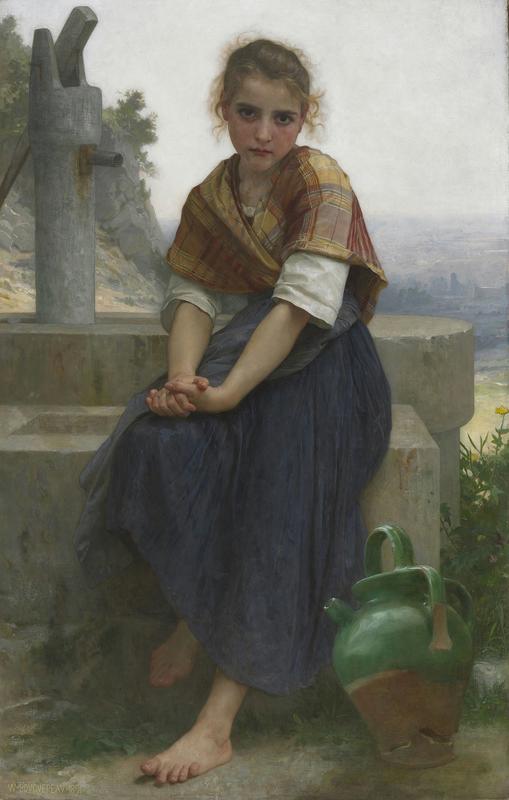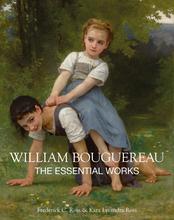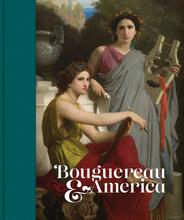More about The Broken Pitcher
- All
- Info
- Shop

Contributor
Critics have placed Bouguereau's The Broken Pitcher in the running for the most sentimental image of all time, and it is a perfect representation of the spirit in his work which would gain him so many haters around the turn of the century.
The haters arrived in droves precisely because of this painting's formal and academic brilliance. Academically, Bouguereau hits all the right notes, demonstrating harmony, proportion, composition, and tone. Visually, it's impressive. Imagine seeing this painting next to an early Picasso—most critics at the time thought that the arrival of various kinds of abstract experimentation made Bouguereau's conservative, academic style trite or irrelevant, partly because it insists on a very clear, direct story, an overwhelming emotional resonance, and a sexual innuendo which is both apparently tame and actually disturbing.
Nowadays, the anti-Bouguereau fervor has dissipated a bit, but historians and curators still do not appreciate him the way they appreciate his teacher's teacher, Ingres, who also did suggestive images of young women. For several decades, The Broken Pitcher was included in teaching manuals and textbooks, with other "single girl figures," as a resource for introducing children to art. It is the narrative of this image, its overwhelming vibe of sadness, its "damsel in distress" theme, which people disliked. If Bouguereau had produced this image outside of the French academy which dominated the study and production of art, it's possible that the backlash would have been less fierce: according to the prominent critic James Baldwin, sentimentality protects people from feelings of inner instability and chaos which can force us to change society for the better, and, likewise, the critics of Bouguereau are often convinced that great art must be a vehicle for political change. From such a perspective, the young woman's demeanor is demonstrating that injustice toward the rural poor is an eternal thing. In this image, critics theorize that the masculine sexual force, represented by the fountain, will always damage the feminine, represented by the broken pitcher, insofar as virginity is a woman's great asset, which she nonetheless must offer to her husband or whoever "takes it," before losing her freedom and purity.
Of course, as with most artworks, there is no hard evidence that the painting is "about" anything at all beyond the plain content of the image, even though the artist is referencing another similar image by Jean-Baptiste Greuze, and even though centuries of European painting had used pitchers and other vessels as euphemistic stand-ins for the woman's reproductive system. It could be, technically, that both men simply wanted to portray young women, or girls, with broken pitchers, and the juxtaposition of woman and object did not mean anything at all in their minds. Does the artist's intention determine the meaning of the artwork? As any artist knows, fortunately or unfortunately, once you release a work, you can no longer control what people think about it. For better or for worse,The Broken Pitcher has, throughout the generations, become a fable of men's preoccupation with virginity.
Sources
- Elam, Michele. The Cambridge Companion to James Baldwin. Cambridge University Press, 2015.
- Hurll, Estelle May. How to Show Pictures to Children. New York: Houghton Mifflin, 1914.
- Nash, Stegen A., Lynn Federle Orr, and Marion C. Stewart. Masterworks of European Painting in the California Palace of the Legion of Honor. Easthampton, MA: Hudson Hills, 1999.
- San Furanshisuko Bijutsukan meihinten. Tokyo: 読売新聞社, 1992.
- Teachers' Monographs, Volume 7. Ithaca, NY: Cornell University, 1905.
- Thompson, James, and David H.T. Scott. The East: Imagined, Experience, Remembered: Orientalist Nineteenth Century Painting. Dublin: National Gallery of Ireland, 1988.
- Wissman, Fronia E. Bouguereau. Petaluma, CA: Pomegranate, 1996.
Featured Content
Here is what Wikipedia says about The Broken Pitcher (painting)
The Broken Pitcher is the artwork of French artist William-Adolphe Bouguereau. The painting was completed in 1891. It was the first artwork of William-Adolphe Bouguereau when he arrived in California. The painting is the symbol of the loss of virginity. In this picture of a young girl with a blue skirt and white shirt covered by a red cloth, she sits beside the broken pitcher. This work is in the Masterworks of European Painting in the California Palace of the Legion of Honor (1999).
Check out the full Wikipedia article about The Broken Pitcher (painting)














